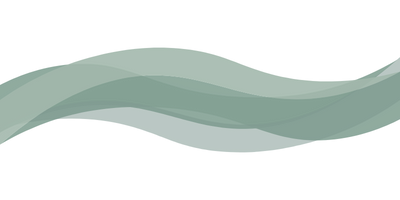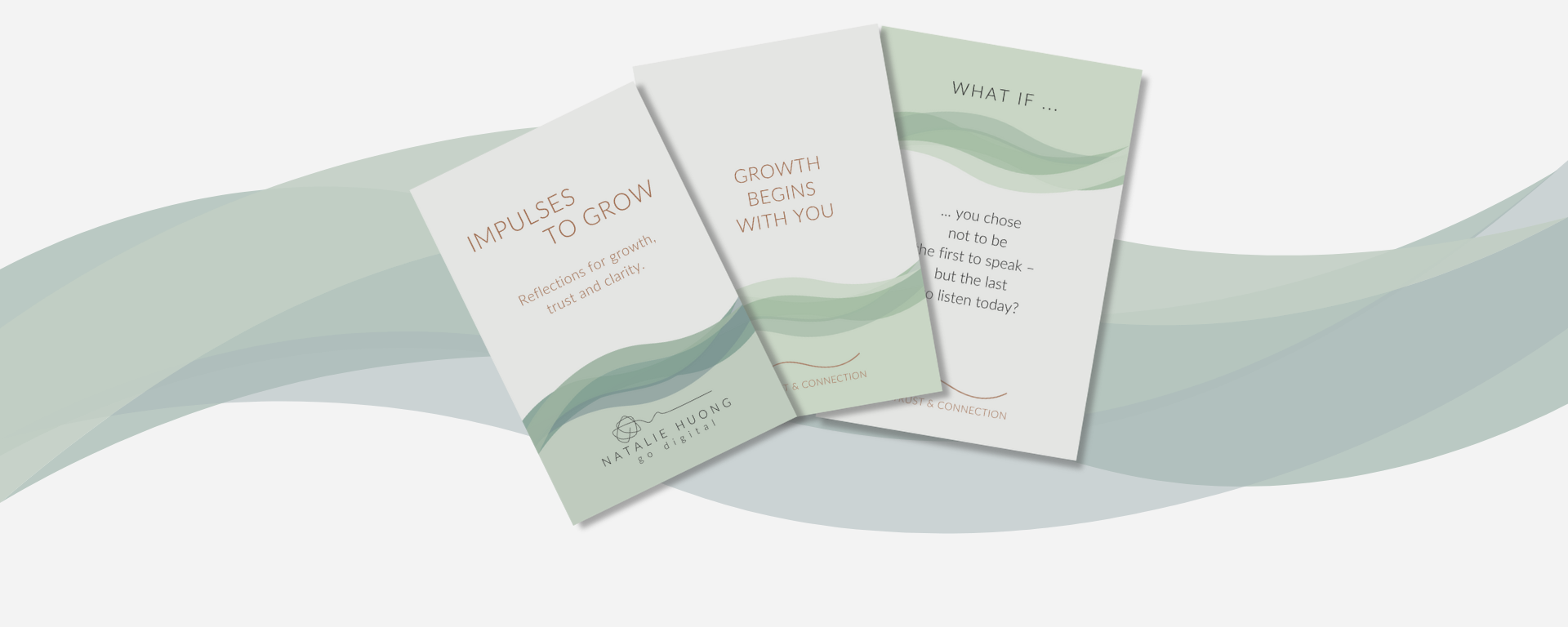
Impulses to grow
Reflections for growth, trust and clarity.
Sometimes growth starts with a small pause.
These cards offer moments to reflect, reconnect and create awareness — for yourself, your team and the way you lead.
How to use the cards
Small questions. Big awareness.
Each card holds a single question — a small impulse to pause, reflect, and grow with intention.
You can use them in three ways:
For yourself - Choose a card when you want to slow down, gain perspective, or start your day with focus.
With your team - Pick a card to open a meeting, reflect after a project, or spark a deeper conversation.
In workshops or coaching - Use the questions to surface insights, build trust and explore new perspectives together.
There’s no right way to use them - only your way.
Four themes - four ways to grow
Growth happens step by step - from building trust to taking action. Together, they form a path from awareness to action:
Build - Trust & Connection
Open - Courage & Openness
See - Clarity & Focus
Act - Ownership & impact
-
Trust & Connection
Growth begins with safety and connection. These impulses invite you to listen, trust and open space for others.

-
Courage & Openness
Courage starts where we show up honestly — and stay curious, even when it’s uncomfortable.

-
Clarity & Focus
Clarity creates alignment. These reflections help you prioritise, communicate and stay connected to purpose.

-
Ownership & Impact
Growth becomes sustainable when we take responsibility — for our actions, our words and their impact.

The ideas that inspire growth
Each impulse is rooted in methods that help us grow - not through theory, but through awareness.
They invite you to look at how we build trust, stay curious, find clarity, and take ownership - every day, in small moments.

Impulses to Grow - Build
Trust & Connection
Trust grows where people feel safe. Connection begins when people feel seen.
Trust begins with how we show up - every day, in every conversation.
It turns uncertainty into shared learning and lays the foundation for meaningful collaboration.
Amy Edmondson
Psychological Safety
A shared belief that it’s safe to speak up, ask questions and admit mistakes — without fear of blame. when safety is high, teams learn faster and innovate more.
In practice
signal curiosity before judgement “What am I missing?”
respond to bad news with “thank you for telling me”
make speaking up a norm in meetings (rounds, 1-minute check-ins)
Reflect
Where do people hesitate to speak — and what would make it safer today?
Deepdive coming soon: psychological safety
Marshall Rosenberg
Nonviolent Communication
A simple way to talk about what matters:
observation → feeling → need → request
Less blame, more clarity and care.
In practice
swap labels for observations “In last week’s review…”
name a real need “I need clarity on scope”
finish with a doable request “Could we agree who owns x by Friday?”
Reflect
Which need do you avoid saying out loud — and how could you phrase it clearly and kindly?
Blog post coming soon: NVC for leadership conversations
Carl Rogers
Active Listening
Presence over performance: listen to understand, not to reply. Reflecting back (“what i’m hearing is…”) helps others feel respected and safe.
In practice
one conversation, one focus: no multitasking
play back key points, then ask one clarifier
leave a beat of silence before offering advice
Reflect — build
Who needs your full attention this week — and what would ‘listening well’ look like for them?
Blog post coming soon: the power of silence

Impulses to Grow - Open
Courage & Openness
Courage is not the absence of fear - it’s the choice to stay open, even when things feel uncertain.
Courage & Openness turn safety into movement. They allow learning to happen - when people share an idea, ask for feedback, or admit they don’t have the answer.
In leadership, openness isn’t about being fearless. It’s about showing up with honesty, curiosity, and empathy, even when it’s uncomfortable.
Carol Dweck
Growth Mindset
The belief that abilities and understanding can grow through effort, reflection and feedback. With a growth mindset, challenges become data — not failures — and learning becomes a continuous habit.
In practice
add “yet” to your language: “We haven’t solved this yet.”
celebrate experiments, not only outcomes.
ask “What did we learn?” instead of “What went wrong?”
Reflect
Where could you replace self-criticism with curiosity today?
Explore the growth mindset blog series
Edgar Schein
Humble inquiry
The art of asking instead of telling. Humble inquiry transforms curiosity into connection by inviting others to share their knowledge, experience and ideas. It’s leadership through genuine interest.
In practice
ask one open question before offering an opinion.
replace “why” with “how” or “what” to stay constructive.
pause before answering - leave space for the other person to think aloud.
Reflect
How often do you ask because you truly want to understand?
Blog post coming soon: Humble inquiry in leadership
Kim Scott
Radical candor
Feedback as an act of care: challenge directly while caring personally. Radical candor helps teams stay honest without losing respect — because the goal is growth, not perfection.
In practice
give feedback in private, praise in public.
ask for feedback before giving it.
use “I noticed…” instead of “You always…”
Reflect
What feedback do you owe someone — and what might change if you shared it with care?
Blog post coming soon: From fear to feedback – how honesty builds trust

Impulses to Grow - See
Clarity & Focus
Clarity creates connection.
When we see the whole picture, our next step becomes clear.
Clarity & Focus bring direction to change. They help us move from reacting to reflecting — from being busy to being intentional. In fast-moving environments, clarity isn’t about knowing everything. It’s about recognising what matters most, understanding how things connect, and focusing our energy where it has real impact.
In leadership, that means shifting from managing tasks to seeing relationships — between people, processes and purpose.
IDEO
Human-centered Systems Thinking
Seeing patterns instead of isolated tasks. Systems thinkers look for relationships — between people, processes and purpose.
Human-Centered Systems Thinking helps you understand how people, processes and structures influence each other. It combines the systemic lens (patterns, relationships, feedback loops) with the design lens (empathy, needs, experience).
Instead of looking at isolated tasks, it invites you to step back and see the whole system — and the human stories inside it.
In practice
map the people involved before jumping into solutions
look for patterns, not symptosm “When X happens, Y tends to follow”
visualise a workflow or journey to reveal friction, gaps or dependencies
ask: “What part of this is structure - and what part is behaviour?”
Reflect
Where might a system - not a person - be creating the real friction?
Where might a wider perspective reveal a connection you haven’t seen yet?
de Shazer & Berg
Solution-focused approach
Progress through what works — not what’s broken.
The Solution-Focused Approach shifts attention from problem analysis toward small, concrete next steps. Instead of asking “Why is this happening?”, it asks “When does it already work — even a little — and how can we build on that?”
It’s a simple mindset shift that reduces overwhelm and increases momentum.
In practice
identify success moments: “When did this already work?”
define the smallest visible next step, not the perfect solution
ask future-oriented questions “What will be better when this improves?”
amplify strengths instead of fixing every weakness
Reflect
Where is progress already visible — and what small step could build on it?
Stephen Covey
Circle of influence
Focus where your energy makes a difference.
The Circle of Influence (Covey, 7 Habits of Highly Effective People) helps separate what you can affect from what you can only observe. It brings calm, clarity and agency — especially in complexity.
By focusing on what’s within reach, you reduce frustration and increase impact.
In practice
list what’s within your control (choices, behaviour, communication)
distinguish influence from concern (what you can affect vs. only follow)
shift your energy from “why it’s hard” to “what I can do now”
use this as a grounding tool during overload or uncertainty
Reflect
Where are you spending energy without influence — and where could you shift your focus?
Coming soon “Leading with focus – what the circle of influence teaches us about agency.”

Impulses to Grow - Act
Ownership & Impact
Growth becomes real, when we take responsibility. Leadership is not about control — it’s about contribution.
Ownership & Impact are about turning reflection into action. They mark the moment when awareness becomes accountability - when we stop waiting for others to change and start taking responsibility ourselves.
In teams, ownership grows when people understand how their actions influence the whole - and impact becomes sustainable when we lead together.
Accountability
Taking responsibility instead of shifting blame
Accountability means owning outcomes - not just tasks.
It’s the ability to say: “This part is mine to improve.” even when circumstances are complex or imperfect.
When teams move from blame toward shared responsibility, collaboration strengthens, trust grows, and impact becomes visible.
Leaders model accountability not by having all the answers but by creating clarity, inviting feedback, and owning how their actions affect others.
In practice
• replace blame with curiosity “What can I influence right now?”
• share responsibility early - before workload or frustration builds
• model accountability in meetings “Here’s what I will commit to next.”
Reflect
Where could taking one small step today create more clarity, trust or momentum?
Coming soon: Creating clarity through accountability – how ownership drives engagement.
Peter Senge
Team learning
Learning loops as a foundation for collective growth
Inspired by Peter Senge’s idea of the Learning Organisation, team learning happens when people reflect together, share insights openly and adjust based on what they’ve learned.
It transforms individual growth into shared progress.
Learning loops — short, intentional cycles of feedback and reflection — help teams move faster without losing awareness.
They make learning part of the process, not an afterthought.
In practice
• Add mini-retros (5 minutes) after key meetings
• Share one insight and one next step — together
• Turn learning into a routine, not a rescue measure
Reflect
What would become possible if your team learned with each other, not only next to each other?
John Kotter
Change Model
John Kotter’s 8-Step Change Model shows how transformation succeeds — not through top-down plans, but through shared vision, participation and consistent small steps.
It moves teams from creating urgency to building alignment, empowerment and reinforcement.
In today’s fast-moving environment, Kotter reminds us that lasting change happens when people understand the why, feel ownership of the how, and contribute actively to the next step.
In practice
• make the vision visible, simple and shared
• build momentum through small wins — not big launches
• empower people to take meaningful action instead of waiting for direction
Reflect
Which next step could turn awareness into aligned action — today?
Dive deeper: The 8 steps for leading change

Growth begins with you.
Growth begins with awareness — with the small impulses that shift perspective and bring people closer together.
Every question is an invitation to pause, to reflect, and to reconnect with what matters most.
If you’d like to explore how these impulses can support your team or organisation,
I’d be happy to hear from you.

Don’t show up to prove.
Show up to improve.
Simon Sinek







